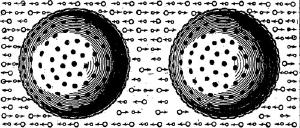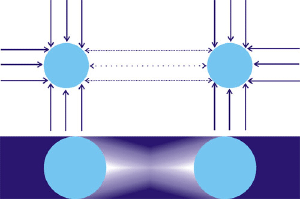Blog
Gravity’s Shadow
21 April 2014
 G.L. Le Sage
G.L. Le SageWhen Isaac Newton presented his theory of universal gravitation it revolutionized our view of the universe. Rather than having a separate set of laws for the heavens and terrestrial physics, universal gravity unified heaven and Earth and marked the beginning of astrophysics. But universal gravity required a strange behavior known as action-at-a-distance. That is, two masses separated by great distances could experience a force of attraction between them without ever being in contact with each other. Just how that was possible wasn’t clear, and Newton’s theory provided no explanation.
 Wikipedia
WikipediaIn 1748 Georges-Louis Le Sage proposed a solution to this problem. He argued that gravity wasn’t due to a mutual attraction between masses, but rather due to the interactions of particles moving through space. In the Le Sage model, the universe is filled with a sea of corpuscles (basically particles) speeding along in all directions. A single mass would be pushed evenly in all directions, thus there would be a downward force toward its surface. Two masses in the vicinity of each other would cause an imbalance between them. Basically, the two masses would cast “shadows” upon each other so that there would be less corpuscles in the region between them. As a result the two masses would be pushed toward each other.
If this kind of “shadow gravity” were real, then it seems that the gravitational force between two masses should be proportional to their size, not their mass. After all, larger objects cast larger shadows. But Le Sage argued that masses are mostly empty space, with small clumps of matter spread throughout the object. The greater an object’s mass, the more numerous the clumps. Thus matter is somewhat opaque to these gravity corpuscles, but more massive objects are less opaque. Thus more massive objects cast darker shadows, and therefore are pushed more strongly to each other.
Le Sage’s shadow gravity model was never very popular, in large part because its focus was to explain the mechanism of gravity without making any testable predictions. Newton’s action-at-a-distance may be strange, but it works extraordinarily well as a physical theory. By the early 1900s, when Einstein developed the general theory of relativity, gravity was seen as a local effect due to the curvature of space. Action-at-a-distance isn’t needed for gravity, and so Le Sage’s idea is generally considered a failed idea.
That hasn’t stopped some from continuing to pursue the model. The idea shows up now and then in alternative (aka fringe) models in various forms. As evidence for their ideas, many point to an experiment known as the lunar eclipse gravity test. If such a shadow gravity model were true, then during a total solar eclipse there should be a small shift in the strength of gravity as the moon shadows Earth from the Sun. Curiously, there have been experiments to test for such an effect, and there may be a strange gravity shift going on.
Most of the tests focus on the motion of a Foucault pendulum during a total eclipse. This was first studied by Maurice Allais in 1954, who noted that a pendulum shifted an extra 13 degrees during a total eclipse. Over the next 50 years similar experiments have been done, with some showing an effect, and some not. It is sometimes referred to as the Allais effect. Although shadow gravity fans argue the Allais effect supports their models, but if that were the case there should also be an Allais effect during a lunar eclipse, which hasn’t been observed. Supporters often note that Allais is a Nobel laureate, but he was awarded the Nobel in Economics, not physics. The most modern tests for the effect using gravimeters and automated pendulums have observed no Allais effect, so even the validity of the effect is questioned.
Perhaps what’s most interesting about Le Sage’s model is how it got some ideas right. With light, shadow effects between dust particles do produce a small net attractive force, and that force follows an inverse square relation just like gravity. It is sometimes referred to as mock gravity. And matter really is mostly empty space, with dense clumps of matter spread throughout an object. We now know that these are the nuclei of atoms.
Sometimes in the pursuit of understanding we create models that are right in some ways and wrong in others. The only way we can separate the good ideas from the bad is to keep testing them against experimental evidence. It’s how we can move our theories out of the shadows.